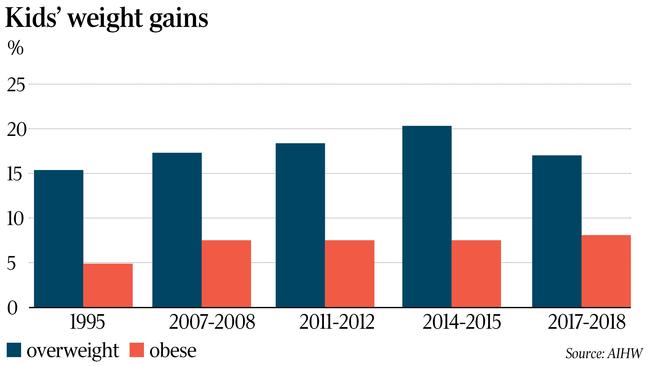Early signs obesity levels thinning
There are tentative signs Australia could be on the cusp of beginning to reverse very high levels of childhood obesity.
There are tentative signs Australia could be on the cusp of beginning to reverse very high levels of childhood obesity, with the proportion of young people overweight or obese declining in the past three years.
The Australian Institute of Health and Welfare reported that the proportion of young people aged between five and 17 was 24.9 per cent in 2017-18, a slight reduction from three years earlier when 27.4 per cent of children were overweight or obese. The rates of childhood overweight and obesity have stabilised generally from 10 to 15 years ago when steep rises were observed. The proportion of children now overweight and obese is the same as it was in 2007-08.

Obesity Policy Coalition executive manager Jane Martin said it was too early to say whether a definite trend was emerging of declining childhood obesity rates. Despite the stabilisation in the proportion of young people who were overweight and obese, Ms Martin said the levels were still far too high.
“If we got another data point and it was going down, you would be fairly confident there was a trend,” she said. “But overall, these rates are way too high, and the fact that some areas are experiencing higher rates of overweight and obesity also shows there are disparities.”
The AIHW report found that the obesity rate among children in the lowest socio-economic areas was more than twice as high as the rate in the wealthiest areas. Inner-regional areas experience the highest rates of childhood obesity, and there have been steep rises in the numbers of Indigenous children overweight or obese.
Overall, 17 per cent of children are overweight and 8 per cent are obese. Despite stabilisation in the numbers of overweight and obese children in the past 10 years, the proportion of those who are morbidly obese has been increasing.
The report also found that rates of overweight and obesity increased as children grew older.
Ms Martin said the positive trends among younger children were due in part to policies around healthy school canteens and childcare centres, and policies to limit the availability of sugary drinks. Advertising junk food to children was one area where greater regulation was needed, she said.
The AIHW report found the imbalance between kilojoules consumed and energy expenditure was predominantly the cause of overweight and obesity; other factors included poor sleep, having parents who were overweight or obese, and exposure to marketing of unhealthy food.




To join the conversation, please log in. Don't have an account? Register
Join the conversation, you are commenting as Logout